We occasionally link to goods offered by vendors to help the reader find relevant products. Some of these may be affiliate based, meaning we earn small commissions (at no additional cost to you) if items are purchased. Here is more about what we do.
Taking the plunge to invest in a real set of cookware, (i.e., something a step or three above that cheap IKEA set), can be a serious project, especially if you’re an over-thinker like me.
While building my wedding registry, I encountered endless choices: stainless steel, nonstick, Teflon, ceramic, and plenty of others, whether frying pans, cooking pots, baking sheets, or some other piece of cookware.
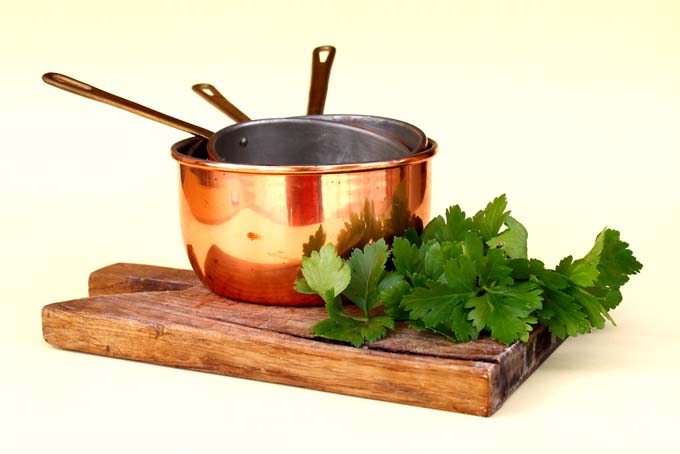
Let’s take a look at a few of my favorite examples, and explore the differences between cast iron and copper.
Cast Iron: The Traditional Choice in North America
Cast iron cookware is extremely popular both with professional chefs and home cooks. In particular, people appreciate the material’s remarkable durability.
As a matter of fact, New York Times food writer Mark Rittman writes that he’s been using the same cast iron skillet for over forty years.
He’s far from the only one out there using antique cast iron; there are countless stories of cast iron frying pans and dutch ovens being passed down for generations (which, by the way, makes it incredibly well-seasoned and your food extra tasty).
Why is cast iron able to last so long?
It starts with the material’s sturdiness. You will never find yourself looking sadly at a pan of food on the floor, still holding the handle.
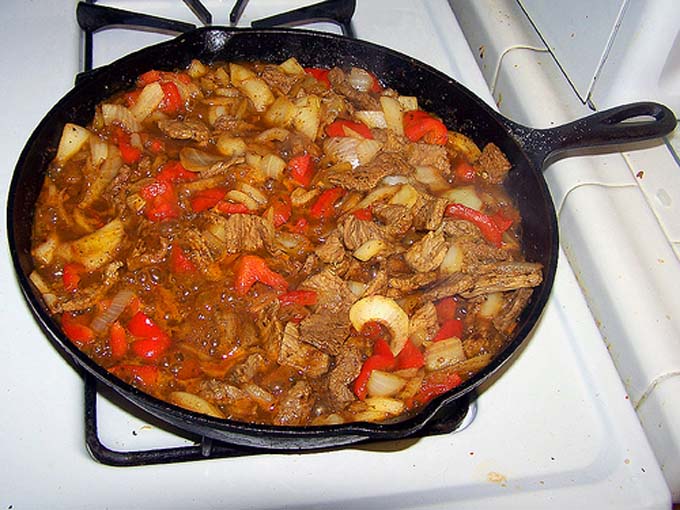
Unfortunately my fiancé wasn’t any help in making a decision; after all, he’s not into cooking like I am and this is a product he’ll only use to reheat leftovers.
After some extensive research, I finally narrowed it down to two choices for the bulk of my food preparation adventures: cast iron or copper.
Benefits
Heat, be it high or low, is cast iron’s best friend. Although it takes its time to heat up, and is not as good at conducting heat as copper, once it’s there, it’s there to stay for a long period. This makes it a great tool for searing or browning meat.
In addition, this type of pan can be taken from the stovetop to the oven, an added benefit that I really appreciate. Preheating on the stove whether you plan to cook your food on the stovetop or bake it helps to address “hot spots,” which means chicken breasts won’t need to dance around the pan to be prepared evenly, and your cornbread will have a uniform crust.
Giant pan cookies and bread bake beautifully in cast iron skillets, and as I mentioned, you’ll find that many traditional cornbread recipes do so as well. Speaking of cornbread, try Jennifer’s jalapeno skillet cornbread for a spicy variation on this southern staple.
If it isn’t enameled, cast iron can withstand the highest temperatures in the oven, beyond the range of what is typically available to home cooks. Seasoning can hold up at up to 700 degrees Fahrenheit.
Its ability to withstand high heat and hold it makes it ideal for deep frying and searing, and as an added bonus, the oil used for deep frying deepens the seasoning every time you use it!
The once-ubiquitous black iron pan is a traditional vessel that may be used to make fried chicken, hush puppies, and all your other favorite deep fried goodies.
Best of all, it works perfectly with all of the new induction stoves that are popular today! Just be sure to use it with care on a glass top range, as the rough surface can scratch.
If seasoned correctly, it is naturally nonstick, so there’s no worry of leaving half a fried egg behind and breaking that lovely yolk. Moreover, it typically isn’t chemically treated, which means it won’t be imparting anything into your food but the flavors of the spices and aromatics that you use in your cooking.
Since cast iron is usually seasoned with oil or another form of fat, I find it adds a richness to the food prepared in it and its flavor deepens over time.
Lodge L8SK3 Pre-Seasoned Cast-Iron Skillet, 10.25-inch, available at Amazon
Frying pans made from this material are also often more affordable than many of their peers. A good quality pre-seasoned ten-inch skillet can be found for just twenty dollars, less if it’s a hand-me-down or thrift store item, and it’s not a piece that you’ll find yourself replacing very often. In fact, if you care for it well, it may never need replacing.
Disadvantages
The many benefits of cast iron cookware do come at a price. Its sturdiness also means serious heft, making the larger examples relatively difficult to clean or transfer to the oven, especially if it has only one handle. Be sure to use two hands when transporting your full pan around the kitchen, and potholders as well.
Those handles get super hot! You may be able to find silicone handle covers that fit nicely for extra protection.
You’ve also got to make sure the shelf that you will use to store all of that iron is sturdy and up to the challenge.
It also takes quite a while for the metal to heat up, which is fine if you have the time, but can be a pain if you’re trying to whip up dinner quickly and you just can’t wait for those steaks to sear.
That also means it takes some time to cool down, which could be annoying for those of you that like to get the dishes done right after dinner.
On that note, cast iron can be difficult to clean if food or the residue left behind is left intact for an extended period. Usually, scraping any bits off, rinsing with hot water, and thoroughly drying (very important to avoid rusting!) will do the job, but there are many methods to clean these depending on how thick of layer you’re deal with.
Scrubbing gently with coarse salt rather than applying any water to these types of pans is a go-to favorite cleaning method of mine.
In order for the cast iron to last and remain nonstick, it has to be “seasoned,” which involves coating it in a thin layer of oil and baking it for several hours. Luckily, you don’t need to do this often, but it’s time consuming to start with, or if you need to reseason your cookware.
To safe time, you may find preseasoned pans that are to your liking.
Furthermore, iron is a reactive material, meaning it’s not a good idea to cook acidic foods in it, like fruit or tomatoes. This can cause damage to the seasoning or even rust spots, which will require removal and reseasoning.
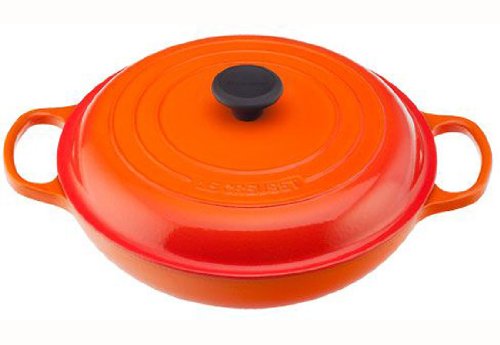
Le Creuset Signature Enameled Cast-Iron Round Braiser, 3 1/2-Quart in Flame, available at Amazon
If you are planning to cook a lot of acidic foods, you may want to consider an enamel lined cast iron dutch oven or cocotte, such as those offered by Le Creuset and Staub.
The porcelain coating is pretty much immune to any chemical reaction, but it a little bit brittle when it comes to clanging and banging it around, so no beating your metal spoon on the side with these. Be sure to store them with care as well.
Copper: A Little Old World Charm for Your Kitchen
Visions of hearty French cuisine, a romantic chateau along the French Riviera, the hustle and bustle of Paris – that’s what I think about when I imagine a collection of copper pots in my kitchen.
However, in spite of the dreamy connotations, copper cookware does live up to the hype in terms of quality, sturdiness, and longevity, and deserves consideration when you are trying to choose the best cooking products for your home.
Benefits
Copper cookware is also very popular, but namely with chefs and more advanced home cooks. It’s a favorite among these groups because of how well it distributes heat, and many would argue that it’s the best type of cookware for avoiding hotspots.
This makes it great for braising, simmering sauces, and preparing somewhat temperamental dishes like hollandaise and risotto.
Unlike cast iron, it heats up and cools down very quickly, meaning you can easily use it to prepare for several components of a meal and get dinner on the table fast.
Copper lasts quite a while when it is well taken care of, although the stainless-lined varieties may not hold up for decades like cast iron.
The thicker tin-lined examples may well last a century or more when maintained with care, if the tin is refreshed as needed – typically 20 to 30 years in a home environment if it is not attacked frequently with metal utensils. When well made, copper pots and frying pans are very solid.
Even though copper cookware tends to be extremely sturdy equipment, you won’t need a spotter when moving a pot full of food from the stove to the oven, as it’s significantly lighter than cast iron.
However, the better, thicker quality pieces will weigh much more than the thin pans you may be used from the department store.
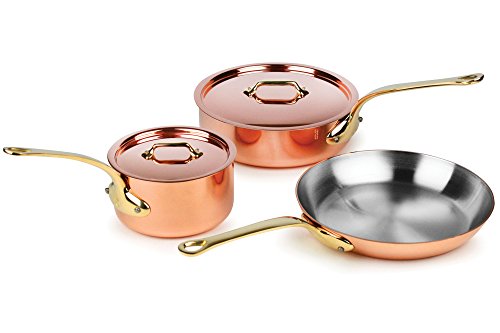
Mauviel M’heritage M250B 5-piece 2.5mm Copper Cookware Set with Bronze Handles, available at Amazon
One of its greatest – and certainly most obvious – benefits is that copper cookware is very attractive. If you have open shelving, you can happily fill it with this beautiful, shiny metal that serves as a pleasant reminder of Old World Europe.
Many cooks even use it for home decor as well as for food preparation by hanging the pieces on the wall or from the ceiling above the stove, and why not? It really is gorgeous.
Not to mention, there’s no harm in showing off a little by letting your friends see that you’ve got what the pros are using…
Although it can be difficult to maintain, copper cookware is pretty easy to clean. Its light weight also means you won’t be struggling to maneuver it in the sink.
It’s totally fine to clean copper cookware with gentle soap and a dish brush or sponge without worrying about damaging the pan or affecting its usefulness.
If tin lined, avoid any sort of steel wool or abrasives of any kind, and go real light with the green scrubby pads. Stainless-lined examples can take a bit more punishment.
Just make sure you dry the pans thoroughly afterwards if you’re trying to keep that spot-free shiny look! Copper polish may also be used occasionally to maintain that beautiful sheen.
Its incredible heat-conducting power isn’t the only reason copper is mostly used by professionals and near-pros, though. Investing in copper cookware is not easy on the bank account, and it’s typically the most expensive option available.
Disadvantages
Although you are paying for a product that will last you a long time, copper requires a lot of upkeep.
First, as mentioned above, it has to be polished frequently in order to keep it shiny. And second, copper on its own is very reactive, so copper cookware is typically lined with tin or stainless steel to make it more versatile in terms of what may be cooked inside.
If it’s lined with tin, it’ll need to be re-tinned every 15 to 20 years or so in a busy home environment – and again, this is if it is not regularly attacked with metal utensils or bumped against other things in the sink. Handle it with care to maintain the finish!
Although it will last quite a while, stainless steel lined copper cookware is expensive, and if you ever do need to have it re-lined, it’ll cost you a pretty penny.
You can use unlined copper products, but this really limits the range of foods you’re able to prepare. Definitely no acidic foods, and lighter colored foods like eggs, can pick up gray streaks from the metal. They are still safe to eat, but not exactly appetizing.
Lastly, most copper is incompatible with induction ranges, as they are not ferromagnetic like iron.
However, there are one or two lines of copper cookware that are compatible with induction and we have reviewed one such set – the de Buyer Prima Matera. These use an induction converter disc to conduct the heat to the pan.
Which to Choose? A Comparison
In the following comparison table, you can see that I’ve listed the various pluses and minuses, pros and cons, of cast iron and copper cookware to help you decide which is the best for your home kitchen. They both have some significant advantages but there are trade-offs as well.
Cast Iron vs. Copper Cookware
| Cast Iron Cookware | Copper Cookware | ||
|---|---|---|---|
| Advantages | Disadvantages | Advantages | Disadvantages |
| Not very expensive! At least for the bare metal/pre-seasoned models. | Heavy! | Superior conduction of heat to all regions of the pan. No hotspots! | Expensive! |
| Bare cast iron is seasoned with natural oils - making for a non-toxic surface. | Seasoning cannot take highly acidic food on a regular basis without be re-seasoned. | Reacts FAST to changes in temperature which helps with sautéing. | Can't take high heat - low and medium heat only (although you will not need as high of a temp from your stove). |
| Soaks up heat and slowly radiates it out. | The porcelain on enameled versions is a little brittle. Avoid hitting it with metal utensils or the bottom of the sink. | Lighter than cast iron. | Tinned lining will need to be re-tinned at some point. |
| Works great with induction stoves. | Not nearly at reactive to changes in temperature as copper (sometime this is good and sometimes bad). | Tinned versions are naturally nonstick. | Stainless liners can (in rare circumstances) separate. |
| Tolerates high heat for searing. | Handle will get HOT! Use often mitts or pott holders (those quilted pieces of cloth your gandma used to keep in the kitchen). | If well treated, will last for years. | Almost all models will NOT work with induction. |
| Seasoning add to the flavor. | Can be expensive for the French manufactured products (cheaper for the Chinese made models). | ||
| Dual use - the frying pans works as well in the oven as the stove top. | |||
What Did I Purchase?
After some brooding, and plenty of research, writing detailed pros and cons lists, and a few (or seven) phone calls to my mom, I settled primarily on cast iron for my kitchen with a few stainless copper “anchor” pieces thrown in, a few enameled cast iron dutch ovens, and even some stainless steel “clad” saute, sauce, and stock pots for the more punishing duties.
It’s not an all or nothing proposition where you must choose one type of material over the other when stocking your kitchen cabinets. Consider what you cook, what you want to achieve, and how often you will likely use certain pieces when making your decisions.

Lodge L5HS3 5-Piece Pre-Seasoned Cast-Iron Cookware Set, available at Amazon
How did I make the call? It came down to three factors:
For one, the stakes are a lot lower with cast iron. Both types of cookware require attention and special treatment, but if I somehow mess it up, I’m not out hundreds of dollars with these pieces.
Two, copper is definitely more finicky when it comes to what can be made in it. If I prepare the wrong thing in my cast iron, I may need to re-season it, but at least I haven’t ruined the pan entirely.
Three, cast iron is more compatible with my style of cooking. It’s perfect for the several times a year when I deep fry a big batch of hot wings before a football game, and I love using dutch ovens to cook a stew low and slow in the oven.
Be sure to use enamel coated products if using these for tomato-based stews. Again, acid foods can eat away at your nice seasoning.
Although it took a while to reach this decision and it was a close call, cast iron cookware will be put to better use in my kitchen, and I’ve asked for a new stainless steel clad set on my wedding registry to round out my collection.
That may not be the case for you, though, and hopefully this will help you reach your own decision!
Have any questions about these types of cookware? What pieces will you add to your collection? Feel free to reach out in the comments below!
And for more tips on selecting essential pieces of cookware for your kitchen, read the following next:
What’s Up with Carbon Steel Skillets?
Cooking Your Way to Great Taste with Cast Iron
Made In Cookware: The Fresh All-American Line of Kitchen Cookware
Originally published by Chelsea Miller on July 27, 2014. Last updated on August 2, 2021. With additional writing and editing by Allison Sidhu. Uncredited photos: Shutterstock.
About Chelsea Miller
Chelsea Miller, born and raised in Portland, Oregon, graduated from the University of Oregon where she discovered both her love of football and cooking great food. She's the founder of the food blog "A Duck's Oven" and began writing for Foodal in 2014.


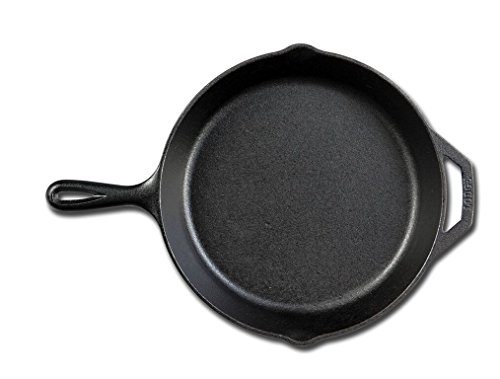

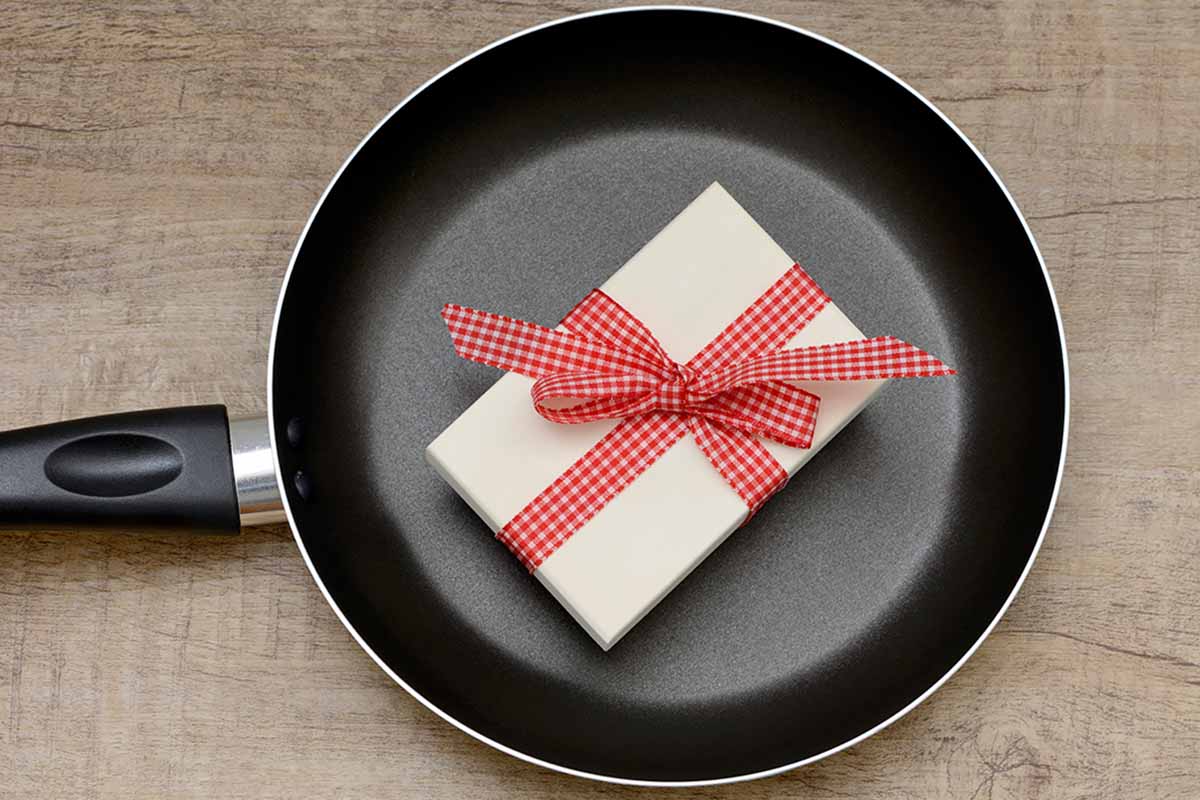

Nothing beats the charm of cast iron cookware although those copper pieces look beautiful. If I were looking to replace my set of cookware, I would probably go with a high quality hard-anodized set with a few cast iron pieces thrown in the mix.
It sounds like you came up with the perfect combination of pieces to make up your cookware set. I am sure you will be preparing delicious meals for years to come with your new set.
I have to agree, I enjoy cast iron. I’m actually not a fan of the few copper pieces I have I never use. Mostly I’m afraid I’ll burn something, so I just steer away from them.
These copper pieces look spectacular, and after listing off the disadvantages and advantages of both, I think I’m going to end up grabbing myself some. Being able to switch between different parts of the dish quickly is really helpful, and means I don’t have to buy myself a huge amount of cast iron cookware to use.
I love how copper looks and conducts the heat, those are two massive pluses. But, due to the overalll look of my kitchen I am going to stick with cast iron. Thanks for doing a side-by-side comparison of the two however, they are two very different choices.
I hadn’t actually considered the differences until now and this was very helpful, I’m going to be switching to copper.
As good as copper looks, I have to be a cast iron girl at heart. There’s just something about it that nothing else can replicate.
I love my cast iron cookware. They can be used for just about anything. I love the look of copper pots and pans and would love to display them in my kitchen. Their polishing/upkeep makes me hesitant though. How much of a hassle is the care? I don’t mind taking care of my dishes to make them last longer but I don’t have a lot of extra time in the day to dedicate toward it.
In your article you mentioned that Cast Iron pans are often passed down from generation to generation. I had to smile because this is how I acquired all of my Cast Iron Pans. Many of them I received from my Grandmother. Different sizes and shapes. Some molded for corn bread and other things. I love her Dutch oven because I can do so many different things with it. I even have some saved out that I keep for taking camping with us. They are perfect to put over a campfire or on the camp stove. Another reason I love them is for their durability.
I hate to say it buy my husband is hard on pans. More than once he has forgotten something on the stove and it is burned onto the pan. A little lemon juice and soaking it on low heat helps to loosen most of this. I scrub the rest out with a steel wool pad and re-season it. Because they are so well used it really is not a problem to re-season them. If it has not had to be scrubbed to much I can do it on the stove top. If I have had to deep clean it I put it in the oven at 175 degrees F. and bake for 1 hour. The key to seasoning is to not overuse the oil. If too much oil is used the pan becomes a sticky gummy mess and the process must be repeated.
One thing I have found in some of the Cast Iron pans being sold today is that they are not as smooth as the ones my Grandmother gave me. It is important to by a good brand and not some of the less expensive ones for this reason. Buy good quality and they truly will last a life time and more. I truly love my Cast Iron. I have tried other pans because they were lighter in weight but I always go back to my dependable Cast Iron.
It is so refreshing to hear that I’m not the only one who loves her cast iron pans! And I LOVED the line about needing a spotter to remove them from the oven sometimes. I have three, two smaller and one good sized one (probably 12″ across) and I use them for baking bread a lot of the time as well.
I believe I got one of them from my mom, and the other two found at second hand stores. My husband couldn’t understand why I wasn’t buying non-stick, but now swears by them too! I’ve converted him, heh heh.
Great post, keep them coming. I love to read your posts.
Sarah
I adore the look of copper pans. Most people I know go crazy about their cast iron, but a nicely lined copper pan always seems to do better for me. I’m very hard on pans and like my acidic foods very much, so these work great. Plus, polishing always seems easier to me than seasoning and not being able to wash it.
I’m in the market for a piece or two right now, although I’ll be keeping my mainstays, so I was interested to read this article. I have hand and wrist limitations, so a whole set of heavy cast iron pans would be out, but I would like to purchase one skillet, particularly for Sunday morning breakfasts. My Dad always used his on Sunday mornings, when cooking us a big brunch, so I have fond memories of his favorite cast iron skillet, and the wonderfully tasty concoctions it produced. I would love to invest in a few copper pans. I am expanding the breadth of my cooking, so will need to look around at recipes prior to buying, in order to determine the best sizes. I do think I will end up with possibly 2 copper sauce-type pans (again, childhood memories), as well as a medium to large sized cast iron skillet. I’m so glad you mentioned the single handle issue. My large frying pan I currently use has an extra handle, and I absolutely love it. It definitely helps with my limitations, as that is an enameled cast iron pan.
I really appreciate this article (not least because I love your style of writing). That said I don’t think copper is what I need in my kitchen – between my family’s love of “soul food” and the fact I’m a bit of sloth…eh cast iron is probably for the best. I will say that it pays to shop around, because cast iron is heavy and the best kinds have very… Very substantial handles to prevent nasty accidents. Anyway thank you again for a lovely comparison between the two.
I never knew that copper cookware had such good heat-distribution properties. If not for the high price and lack of space in my kitchen, I’d look into purchasing a set. Maybe after we do some remodeling and add some open-shelving we’ll consider grabbing a few pieces, but our cast iron and non-stick sets are doing great right now.
My grandmother on my father’s side is from the Old Country, and she swears by cast iron. On the other hand, copper certainly is beautiful. From reading the article, I might have to go with you on cast-iron, if only because of the cost-effectiveness. I like the fact that copper has good heat distribution, because right now that is a HUGE problem for me. I think I might get a copper saucepan and kettle, and stick with cast iron for my frying needs. Thanks for posting all this great information!
Wow your article very informative. Thanks for sharing such a useful post.
You mentioned copper and cast iron, but what about other metals like stainless steel and aluminum or ceramic.
You can find more of our articles that cover cookware of different materials here. 🙂
????? Well I may purchase a combined Copper Cast Iron Skillet
You people need to proofread what you write. This article is loaded with errors. Shame on you!
Wow, 2014 – I have to admit, this article was published before my time and must have slipped past the editing team. Thank you for your input! The article has been updated, and will receive a fuller revamp in the near future.
Here’s a trick I use for cooking tomato and other acidic sauces in my black seasoned cast iron.
Just use Pam or a similar canola oil cooking spray and spray your cast iron down while you bring it up to temp.
Then do your cooking.
Then when done cooking put that spaghetti sauce in a serving dish. Rinse out the pan immediately in hot water and use a scrub brush to remove cling-ons.
When clean, dry thoroughly and set the pan back on the stove on low heat and re-spray with Pam.
Let it simmer as you clean up the kitchen. Allow it to cool while you eat. Put it away at the end of the meal.
I love spaghetti and cook the sauce in my cast iron weekly. I haven’t needed to do a major re-seasoning in over 25 years.
I use the same technique when using my cast iron to bake acidic fruit and berry pies, or when using my Dutch oven to slow cook tomato based stews.
Thanks for sharing, Jack. This sounds like an excellent upkeep routine!
I have cooked in restaurants for many years. Most restaurants don’t supply copper to the line cooks. They probably do in Europe. However, at home I mainly cook with stainless lined copper. It is very expensive but well worth the price. As I have wandered through European kitchens, all have copper, few polish them. It does not effect the cooking and the look of unpolished copper is very old world and charming.
I have never purchased a full set because I like to pick and choose what I need and not let someone else choose for me. That way I can budget for my purpose and not waste money. Cast iron is heavy and I don’t like waiting to create a pan sauce. Copper is the one that exceeds my needs and I am pretty well versed in cooking styles. That is not to say I don’t appreciate the cast iron skillet’s ability to sear a steak. I just don’t eat steak that often, and copper can give a good sear. It really depends on what you eat. The price is daunting for copper so if you are just starting out a cast iron pan is economical and hard anodized aluminum is a great choice. Copper is something you work up to!